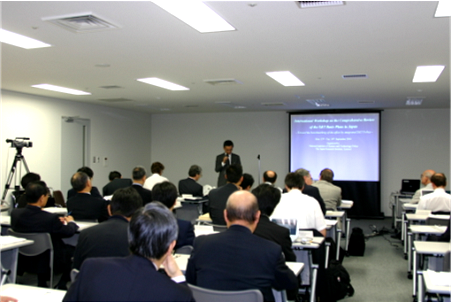目次
- Ⅰ.トピックス
- 日本の特許出願グローバル戦略
第2研究グループ客員総括主任研究官 近藤 正幸
第2研究グループ主任研究官 富澤 宏之
第2研究グループ 上野 泉
- 日本の特許出願グローバル戦略
- Ⅱ.海外事情
- クラスターの展開とネットワークの役割
第3調査研究グループ 日本学術振興会フェロー Ana Colovic
- クラスターの展開とネットワークの役割
- Ⅲ. 最近の動き
 Ⅰ. トピックス
Ⅰ. トピックス
日本の特許出願グローバル戦略1
はじめに
日本の科学技術の競争力はIMDの世界競争力ランキングでも高く評価され、特許も多いというのが定説になっている。 本報告では、確かに米国登録特許においては日本が健闘している事実を踏まえた上で、まず、日本の世界における特許出願のシェアが急速に低下している実態を世界知的所有権機構(WIPO)のデータを用いて米国と比較しながら指摘する。次に、その急減の要因について分析し、日本が主な出願先にしている日本の特許庁に出願される特許の割合が世界において大幅に減少していること、その日本の特許庁に出願される特許に占める日本の割合が低下したことが大きな原因であることを明らかにする。米国は逆に世界における特許出願シェアを高めており、日本とは出願戦略に大きな相違があることを明らかにする。最後に今後の研究計画について述べる。
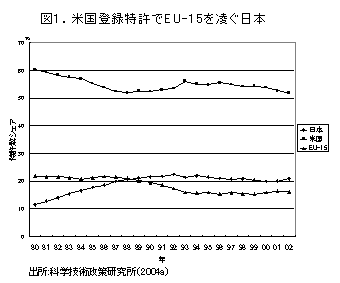
|
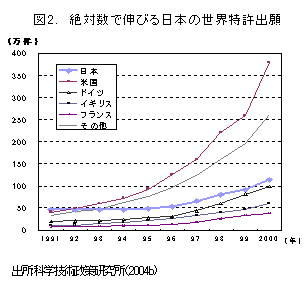 |
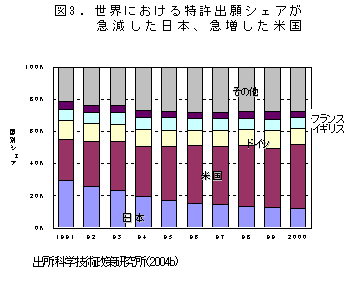 |
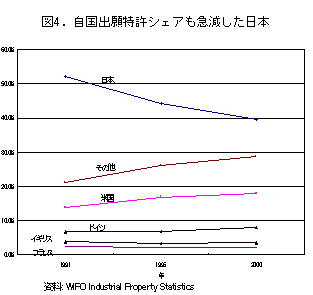 |
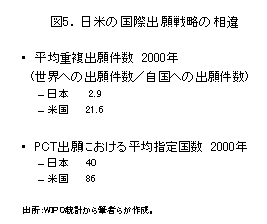 |
米国登録特許で健闘する日本
日本の特許(出願人の国籍が日本の特許)は、世界の企業等がその市場を目指して出願する米国における特許において健闘していることはよく知られている。CHI社による2002年の米国登録特許のトップ10を見ても6社が日本であり、米国3社、韓国1社となっている。世界の3極別に見ても、日本は1980年代末からEU-15を凌ぐようになっている(図1)。
世界における特許出願件数においても、日本はその件数を伸ばしている(図2)。1991年には約47万件であったものが、2000年には約113万件に伸びている。しかし、世界の中で日本が占める割合の状況は次に見るように大きく異なっている。
世界における特許出願のシェアが急減した日本、急増した米国
米国登録特許で健闘し、世界における出願件数でも絶対値を伸ばしている日本であるが、世界における出願件数シェアはこの10年ほどで急減している。1991年には30%近くあったシェアが2000年には12%を下回るようになっている(図3)。
逆に、米国は世界における出願件数シェアをこの10年ほどで急増させている。1991年には25%程度であったシェアが2000年にはほぼ40%にまでなっている。日米以外の国についてみると、英独仏についてはあまり大きな変化はないが、その他の諸国が21%から27%を超えるようになっている。
世界における特許出願は、各国ごとに特許を申請する必要があることから、同一内容の特許が出願人の戦略に基づいて各国に出願されることになる。そこで、出願人の自国への出願のみを対象にして世界におけるシェアを計算しなおしてみた。その結果を見ても日本のシェアが大きく下がっていることが分かる。1991年の52%から2000年の40%を切るところまでの大きな減少となっている(図4)。
日本の世界特許シェア急減の要因
日本の特許出願件数が世界においてそのシェアを急減させた要因を各国の特許庁が受理する特許件数の世界におけるシェアの変動(世界の国別の構造変動)とその国における日本からの特許出願件数のシェアの変動(日本の各国シェア変動)に分解して分析した。その結果、1991年には日本の特許の出願先として7割以上を占めた日本の特許庁が受理する件数の世界におけるシェアの変動が大きく影響していることがわかった。1991年に比べると2000年には18%ポイントも減少した。さらに日本の特許庁が受理する特許における日本からの出願特許のシェアも1991年に比べると2000年には11%ポイント減少した。日本が比較的多くの特許を出願している米英独仏についても規模は小さいが同じ傾向にある。つまり、これらの国の特許庁が受理する特許の世界におけるシェアが減少し、これらの国における日本からの特許出願のシェアも減少している。その他の国については、受理する特許の世界におけるシェアが増加しており、日本からの出願シェアも若干ながら増加しているが、全体に及ぼすプラスの効果は小さい。
総括的に言うと、1991-2000年の日本の特許の世界シェアの変化は(日本の各国シェアを1991年に固定して計算すると)世界の国別の構造変動による分がマイナス17%ポイント、(世界の国別の構造を1991年に固定して計算すると)日本の各国シェア変動による分がマイナス3%ポイントであり、世界の国別の構造変動に日本の出願構造が対応していなかったことが急減の主な要因であることがわかる。
米英独仏については、自国が受理する特許件数の世界におけるシェアは日本と同じように減少しているが、これらの国については自国に対する出願の世界への出願に対する割合である自国出願割合が日本に比べて低いことがこれらの国の世界における全出願のシェアの低下を小さいものにしている。1991年の米英独仏の自国出願割合は25%未満程度であった。
米国については世界におけるシェアを大きく伸ばしている。1991年から2000年にかけて14%ポイント以上も世界におけるシェアを伸ばしている。米国は自国を始め、日英独仏、その他の国のすべてにおいてそのシェアを伸ばしている。特に、受理件数で世界におけるシェアが37%ポイントも高めたその他の国において10%ポイント以上もその割合を高めていることが大きく影響している。
総括的に言うと、1991-2000年の米国の特許の世界シェアの変化は(米国の各国シェアを1991年に固定して計算すると)世界の国別の構造変動による分がプラス4%ポイント、(世界の国別の構造を1991年に固定して計算すると) 米国の各国シェア変動による分がプラス8%ポイントであり、世界の国別の構造変動に米国の出願構造が対応していることもあるが、各国において積極的にシェアを伸ばしたことが急増の大きな要因となっていることがわかる。
日米の世界特許出願戦略の相違
日本が世界におけるシェアを大きく下げ、米国が世界におけるシェアを大きく上げた要因を見るために特許出願の重複度について分析した。その結果、日本の特許の場合は自国への出願が多く、2000年でみると自国への出願件数で世界への出願件数を除した出願の重複度は2.9である(図5)。米国の場合はこの重複度が21.6と日本の7倍以上になっている。ドイツの場合も12.5となっていて日本よりはかなり大きい値となっている。
国際的な特許協力協定に基づくPCT出願についても日米の相違は明確になっている。2000年でみると日本からのPCT出願については指定国数の平均が40であるのに対し、米国からのPCT出願については指定国数の平均が86と倍以上になっている。
今後の研究計画
本報告で、米国とは対照的に、日本の世界における特許出願シェアという量的な指標が急減したということを明らかにした。今後は日本の特許の質がどのように変化したのかという点について、被引用度の変化及び多項制の導入に伴う特許1件あたりの請求項目数の変化について分析を行う予定である。特許1件あたりの請求項目数の分析については、日本に出願された特許、米国に出願された特許について分析を進めている。
また、研究開発費との関係でみた日本の特許生産性の動向についても分析を検討している。
さらに、日本の海外での特許戦略を見るために、日本企業の海外直接投資、海外研究所立地、技術貿易、ハイテク貿易との関係についても分析を検討している。
参考文献
科学技術政策研究所 (2004a) 「基本計画の達成効果の評価のための調査 科学技術研究のアウトプットの定量的及び定性的評価 平成15年度調査報告書」、NISTEP REPORT No. 79。
科学技術政策研究所 (2004b) 「基本計画の達成効果の評価のための調査 -平成15年度における主な成果-」、NISTEP REPORT No. 74。
1 本稿は日本知財学会「日本知財学会第 2 回学術研究発表会講演要旨集」に掲載された論文を日本知財学会の許可を得て転載したものである。
 Ⅱ. 海外事情
Ⅱ. 海外事情
クラスターの展開とネットワークの役割
 |
アナ・チョロビッチ
パリ第 9 大学講師・経営学博士課程在籍中。 (2004年11月Ph.D.取得見込み) 「日本の各地域における産学連携の現状・動向」の研究のため、日本学術振興会サマー・プログラムフェローとして、当研究所第3調査研究グループに2004年7月より約6週間滞在。
|
はじめに
最近 10 年間、クラスター、すなわちハイテク産業のイノベーティブな企業集積の展開への関心が高まってきた。これは、シリコンバレーなど、クラスターの成功例がある一方で、グローバル化に伴い産業発展の新しい方向を見つける必要性に基づくものである。多くの国では、いかにしてクラスターを創成し、発展させるかについての意識の高まりが見られ、日本もその例外ではない。経済産業省による産業クラスター計画は2001年から実施され、文部科学省による知的クラスター計画は2002年から実施されている。
本稿では三つのクラスター関連トピックに対する私見を述べる。まず、クラスター創出について論じ、次に、日本でのクラスター政策実施に対する意見を述べる。最後に、クラスター展開のためのネットワークの役割について概括する。
1. クラスターは政府によって作ることができるか?
クラスター展開に係る政府組織の役割には三つの見方が挙げられる。第一は、クラスターは政府の政策や組織により作られるという、トップダウンアプローチである。第二は、クラスターは企業や研究機関というアクターによって自然に作られるものであり、政府の試みは無用であるというものである。仮に、政府の試みによりクラスターのようなものが作られても、政府の援助がなくなれば消滅する。最後に、第三の意見は、クラスターはトップダウンでは作られないが、政府がクラスターの創成や成長に一定の役割を演じるというものである。
私の見解では、一般にクラスターは産業地域と同様、自然に発生する。世界のクラスターを見ると、その多くはボトムアップ的な動きにより生まれている。つまり、クラスター形成のための共同活動を起こし、従事している地域のアクターの働きによりクラスターが出現してきた。あるケースでは、特定の分野で先進的な企業が生まれたことから、いろいろなアクターが集まるし、別のケースでは、大学発ベンチャーが生まれ、その成功が地域の他の企業の呼び水になることもある。したがって、地域のアクターがボトムアップの動きにより、クラスターを生み出している。理論的には、政策によりクラスターを作ることは可能であるが、私はこういった試みのほとんどが失敗していると考えている。この最大の理由は、クラスター・メカニズムを理解し、作ることが非常に難しいことによる。知識集約的な交流やネットワークによる協力といったクラスター・メカニズムなしには、本当のクラスターはあり得ないのである。
しかしながら、私は、政府は将来性のある企業やプロジェクトを見つけ出し、それらを援助するという役割を果たすことができると考えている。政府の役割は、地域のアクターたちの活動を進めやすくすることである。
2. 日本におけるクラスター計画の実施
日本のクラスター計画の枠組みの中で、地域における産学連携支援組織設立のため、また産学連携プロジェクトのためにかなりの予算が投入されている。私は経済産業省と文部科学省のクラスター計画の対象であるTAMA、浜松、そして札幌の3地域を訪問した。私は日本の官僚組織や産学連携へのファンディングをまだ必ずしも良く理解できていない。しかしながら、多くの公的資金が二つのクラスター計画の実施のために無駄に使われていると感じずにはいられない。私がこのように感じる理由は三つある。
まず、オーバーラップすることもある、二つのクラスター計画の存在である。ある地域は知的クラスター創成事業と産業クラスター計画両方の対象となっている。二つの計画間での調整が必要であることは明らかである。さらに、経済産業省と文部科学省が二つのプランを一つに統合するよう真剣に検討すべきであろう。
次に、支援組織が挙げられる。産学連携推進という全く同じ仕事をしているいろいろな組織、オフィスがあるように思われる。これは一つには二つのクラスター計画があるためである。私はこのような組織がいくつもあると、大学や企業といった地域のアクターに対して組織が不透明に映り、どのような場合にどの組織に連絡を取ったらよいのか不明確になると考える。言うまでもないことだが、いくつかの組織やオフィスを財政的に支援し、本来ならば一つのポストで済む職に数人のスタッフを雇うことにより、公的資金が無駄に使われている。
三つ目はプロジェクトファンディングである。企業や研究所は応募すれば、プロジェクトによっては公的資金を受け取ることができる。これは多くの企業や研究者には、労せずに資金を得られる近道と考えられている。すなわち、良い応募書類を書くことがきわめて重要であり、プロジェクトがあまり良くなくても、うまく応募書類を書くことにより、資金を獲得することが可能になる。これに関係するのは、資金を獲得するプロジェクトのイノベーティブさと知識集約度の低さである。日本では、産学連携、ベンチャー企業はクラスターに関わるキーワードである。クラスターの育成に関わる多くの研究者や役人は、ベンチャー企業を収益の見込みがあり、イノベーティブな組織と同義に捉えがちである。しかしながら、実際にはそうではない。ベンチャー企業と考えられている多くの企業は失敗に終わる。多くは、政府の補助金が途絶えると消滅してしまう。さらに、このような多くの企業のイノベーティブな能力と知識集約はまた議論を呼ぶ問題である。私が浜松、札幌、そしてTAMAを調査した結果、資金が投入されているプロジェクトでイノベーティブさとハイテクという特徴を持ち合わせているケースはほとんどなかった。調査した浜松の1ケースのみが知識集約的で、ハイテク関連であり、その他はすべて普通の製品開発であった。さらに、私は普通の町工場で行われている製品開発プロジェクトの中には、クラスター計画の枠組みで支援されているものよりずっと高度なものがあることを指摘したい。
3. ネットワークの役割
私が指摘したい第三の点は、クラスターにおけるネットワークの役割である。先に述べたように、クラスターをクラスター足らしめるものは、クラスター・メカニズムである。そして、鍵となるメカニズムは、知識集約ネットワークである。ネットワークはクラスターの核となる特徴の一つであり、知識集約的な交流が起こるチャンネルである。新しいプロジェクトが起こり、イノベーションが起こり、新しい知識が得られるのは、他者との相互作用を通じてである。ネットワークは概して長期的視野に立っており、関係者の信頼を前提とする。ネットワークはそのメンバーに、学習、経済的便益といった利益をもたらす。
今や、企業間のネットワークは日本の各地に見られる。日本の産業を見ると、主な特徴の一つは企業間ネットワークであることが分かる。ネットワークには、下請け関係によるもの、「仲間」関係によるもの、中小企業のイノベーティブなもの、共同して注文を取るものなど、様々なものがある。最も高度で協力度が高いネットワークは、何百の、ある場合は何千もの製造企業が集まる産業集積に見られる。ネットワークを通じて、企業は相互に作用し、様々な交流をする。
このように、ネットワークは日本の産業に広く見られる。ネットワークは重要な要素だが、クラスター発展には十分ではない。実際には、より知識集約的なネットワークが求められている。これが産学連携が必要な所以である。特に、小さい企業は、企業規模が小さいため、またイノベーティブな能力が欠けているため、大学と協力する必要がある。
日本のクラスター計画はこのような大学と企業の協力関係の構築を重要視している。しかしながら、短期間だけ、または一つのプロジェクトで終わってしまう共同研究のために、研究者と企業をマッチングさせるのでは、知識集約的ネットワークの構築にはつながらない。真のネットワークは長期のコミットメントと協力を要する。このようなネットワークは日本にはまだあまり見られない。これにはいくつか理由があるが、ここでは二つのみ挙げることとする。まず、多くの場合、大学で受ける教育は企業でうまく活用されていない。例えば、ある学生が有名大学文学部を卒業し、有名大学を出たというだけで、ある企業のエンジニアリング部門の職に就くことは問題である。これでは、大学と企業のネットワーク作りは起こらないだろう。もちろん、オンザジョブ・トレーニングにはいくつかの利点があるが、大学教育の役割を考えることも重要である。二点目は、多くの大学教授と小企業の社長のメンタリティーがかけ離れていることである。両者が違いを乗り越えるようにすることで、産学連携が促進されると考えられる。
結び
最後に、私は知識集約クラスターを作るためにはクラスター・メカニズムが重要であると指摘したい。鍵となるクラスター・メカニズムは、学術界と産業界の知識集約的な、長期目標を持ったネットワークである。こうしたネットワークは日本ではまだあまり見られない。したがって、このようなネットワークの構築を可能とするため、どうしてまだ存在しないのかという理由を深く追求することが重要である。私は、これらの理由が産業界と学術界の両方にあると考えている。
(本稿は、著者の英語原文を第3調査研究グループ 植杉 紀子が翻訳したものである。)
Cluster Development and the Role of Networks
During the last ten years or so, there has been increasing interest in developing clusters- agglomerations of innovative firms in high-tech industries. The triggers for such interest were the cluster success stories (such as the Silicon Valley) on one hand and the need to find new directions for industrial development in a globalizing world on the other. In many countries, we could witness a growing reflexion on how to generate and promote clusters. Japan is no exception. The implementation of the Industrial Cluster Plan, designed by METI has started in 2001. The Intellectual Cluster Plan, designed by MEXT is being implemented since 2002.
In this short article, I would like to express my thoughts on three cluster-related topics. First, I wish to discuss the creation of clusters. Second, I would like to write a few words on cluster plan implementation in Japan. Finally, I shall outline the role of networks in the cluster development.
There are probably three points of view as to the role of the government institutions in developing clusters. According to the first one, clusters can be generated by the government's policies and institutions. This is a kind of a top-down approach. According to the second, government efforts are useless, because clusters can only be created naturally, that is by auto-organization of actors - firms and research institutions. This means that only bottom-up emergence can be successful. Even if a government's action creates a cluster-like formation, this formation will disappear as soon as the action stops. Finally, the third view agrees that clusters cannot be created by top-down measures, but believes that government can have a role to play in accompanying the cluster creation and growth.
In my view, in general, clusters emerge naturally, as do industrial districts. If we look at clusters around the world, we can see that the great majority of them were created through bottom-up actions, that is, they emerged because local actors organized and engaged in cooperative activities leading to a cluster formation. In some cases, there was a leading firm in a particular field and then other actors concentrated around it, in other cases a university generated start-ups, the success of which attracted other firms to the region etc. So, the actions of local actors create clusters through a bottom-up emergence. Even though in theory it is possible to create a cluster by a policy I believe that most attempts fail. The biggest reason for this is that cluster mechanisms are extremely difficult to grasp and produce. And without cluster mechanisms (such as knowledge-intensive exchange and cooperation through networks) there are no real clusters. Nevertheless, I argue that the government can have a role to play in detecting promising firms and projects and in supporting them. The role of the government is to make things easier for local actors.
Within the framework of the Japanese cluster plans, significant funds have been engaged in creating industry-academia collaboration support institutions in Japanese regions and in financing projects in which universities and industry collaborate. I visited three regions targeted by the METI and MEXT cluster plans - TAMA, Hamamatsu and Sapporo. I admit that I still do not quite understand the Japanese bureaucratic system and industry-university collaboration funding. However, I cannot help feeling that a lot of public money is being wasted for the implementation of cluster plans. There are three basic reasons for making me think so.
The first reason is the existence of two cluster plans, which in certain cases overlap. Some regions are targeted both for Intellectual and Industrial cluster development. It is obvious that more coordination between two plans is indispensable. Moreover, I suggest that METI and MEXT should seriously think about merging the two plans into a single one.
The second reason refers to the supporting institutions. There seem to be different institutions and offices, which are in charge of doing exactly the same things - promoting university-industry collaboration. This is partly due to the existence of two cluster plans. I believe that the multiplicity of such offices decreases their transparency for local actors - universities and firms and creates confusion as to which office should be contacted in which case.
Needless to say that money is wasted for financing several institutions or offices and for employing several persons for one single real job position.
The third reason refers to project funding. Firms and research institutions can receive public funding for certain projects if they apply for it. This is seen by many firms and researchers as a great opportunity to have an easy access to funds without much effort. It seems then that writing a good application form is particularly important. Even if the project is not really good, financing can be obtained by an adequately written application form. Linked to this is the problem of low innovativeness and knowledge intensiveness of the projects that receive the funding. In Japan, industry-academia cooperation, start-ups and venture businesses have been the key words related to clusters. A large number of researchers and public officials engaged in cluster development tend to take start-up and venture business as a synonym for profitable and innovative organization. However, the reality is quite different. Many companies regarded as start-ups and ventures fail. Many of them will disappear as soon as they stop receiving government subsidies. Moreover, the innovative capacity and knowledge intensiveness of many such firms is also a very disputable question. The data from my fieldwork in Hamamatsu, Sapporo and TAMA show that very few projects funded are characterized by high innovativeness and high technology. Of several projects about which I learned only one (in Hamamatsu) was truly knowledge intensive and high-tech related. All the others were ordinary product development. Moreover, I would argue that some of the product development projects that are taking place in the ordinary town factories are more advanced than some of those supported within the framework of the cluster plans.
The third point on which I wanted to reflect is the role of networks in clusters. As I said earlier, what makes clusters real clusters are cluster mechanisms. And one key mechanism are knowledge intensive networks. Networks are one of core cluster features. They are the channels through which knowledge intensive exchange takes place. It is through interaction with others that new projects emerge, that innovation takes place and that new knowledge is built. Networks are typically long-term oriented and assume the existence of trust between the involved parties. They provide many benefits for the network members: learning, economic benefits and others.
Now, inter-firm networks are widely present in Japan. If we look at the Japanese industry, we can easily understand that one of its major features are inter-firm networks. These networks are of different types - subcontracting networks, informal confrere (nakama) networks, SME innovative networks, joint order obtaining networks etc. The most advanced and dense cooperative networks are found within industrial agglomerations, in which hundreds and in some cases thousands of manufacturing firms concentrate. Through networks, firms interact, they engage in different kinds of exchange.
So, networks are widely present in the Japanese industry. This element is very important but it is not sufficient for cluster development. In fact, more knowledge-intensive networks are needed. So that is where industry-academia relationships become important. In particular, small firms need to cooperate with universities, due to their small size and the lack of innovation capabilities.
The Japanese cluster plans insist on creating such relationships. However, matching researchers with the industry for short-term or one-project-only cooperative activities does not make such relationships networks. Real networks require long-term commitment and collaboration. These networks are still rare in Japan. There are several reasons for that but let's just mention two. First, it seems to me that in a large number of cases the education received at universities is not fully used in companies. If a student graduates in literature from a famous university and then enters a company at an engineering position, just because he graduated from a famous university there seems to be a problem. The creation of network ties between the university and the firm will not take place. Of course, on job training has some advantages, but it is necessary to think about the role of university education too. The second point is that the mentalities of many university professors and small-firm presidents seem to be worlds apart. So, both sides need to think about overcoming their differences, which could possibly lead to industry-university collaboration.
As a conclusion, I would say that in order for knowledge intensive clusters to be created cluster mechanisms are essential. One key cluster mechanism are knowledge-intensive long-term oriented networks between members of academia and industry. These networks are still very few in Japan. So, in order to make the existence of such networks possible, a deep reflexion on the reasons why they are absent is necessary. I believe that these reasons will be found both within the industry and the academia parties.
 Ⅲ. 最近の動き
Ⅲ. 最近の動き
| ・9/2 | Mr. Joaquin Villa: スペイン・ギプスコア県副知事を団長とするバスク・ギプスコア訪日技術調査団一行 |
| ・9/10 | Dr. Balowin Ngubane: 南アフリカ大使館大使 |
| Mr. Vuyani Lingela: 同大使館参事官 | |
| ・9/13 - 14 | Prof. Luke Georghiou: 英マンチェスター大人文学研究担当副学部長兼PREST理事 他 |
| (「基本計画レビュー調査」国際ワークショップ) (表紙写真) | |
| ・9/17 | Prof. Steven Collins: 米国Washington大学ボセル校助教授 |
| ・9/19 | Mr. Tao Wenyi: 中国 (国立) 江南大学学長及びバイオテクノロジー学科教授 (Ph.D.) |
| Mr. LI Hunazhong: 同教授 | |
| Ms. Tang Lei: 同理学部バイオテクノロジー学科助教授 |
| ・9/7 | Dr.Daniel Malkin: OECD科学技術産業局 (STI) 科学技術政策課 (STP) 課長 |
| 「OECD科学技術政策委員会 (CSTP) の最近の活動 | |
| ・9/13 - 14 | 「基本計画レビュー調査」国際ワークショップ |
| ・9/30 | 持田 勲: 日本エネルギー学会長・九州大学産学連携センター特任教授 |
| 「日本のエネルギー環境産業技術の基盤と開発の動向〜化石資源とくに石炭に注目して〜」 |
| ・9/29 | 八木 晃一: 科学技術動向研究センター客員研究官 |
| 「材料データベースの課題と将来展望 - 世界で使われる材料データベースを目指して - 」 | |
| 小松 裕司: 科学技術動向研究センター情報通信ユニット特別研究員 | |
| 「平面ディスプレイ技術の研究開発動向」 |
| ・ | 「科学技術動向 2004 年 9 月号」(9 月 30 日発行)
|
| 特集 1 二つの合理性と日本のソフトウェア工学 | |
| 客員研究官 林 晋 客員研究官 黒川 利明 |
|
| 特集 2 材料データベースの課題と将来展望 - 世界で使われる材料データベースを目指して - | |
| 客員研究官 八木 晃一 |


